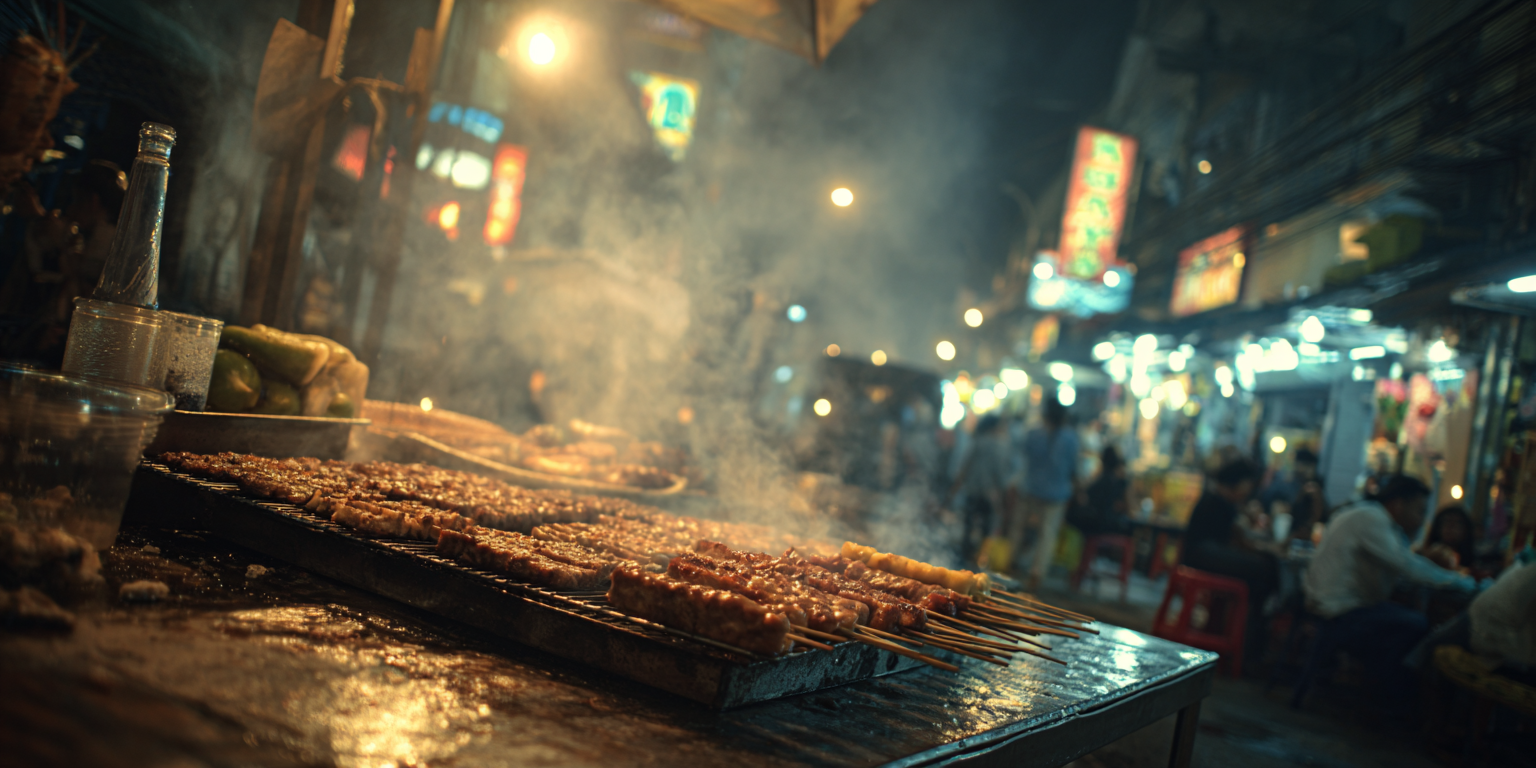The Real Pulse of the City Beats After Dark
Did you know that many of Manila’s most iconic dishes aren’t found in fancy restaurants, but are served on a simple bamboo stick under the glow of a single lightbulb? The city’s energy shifts dramatically after sunset. The relentless daytime heat gives way to a cooler, more electric hum, and with it, the sizzle of oil and the fragrant smoke of charcoal grills begin to perfume the air. This isn’t just about finding a cheap meal; exploring Manila’s street food at night is a direct line to the city’s soul, a delicious and unfiltered lesson in Filipino culture, resourcefulness, and community.
My journey began in Poblacion, the historic heart of Makati. Once the original settlement of the city, it’s now a wonderfully chaotic mix of old churches, residential homes, and a vibrant nightlife scene. Forget the polished gleam of the nearby central business district; this is where Manila gets real. I used a ride-hailing app, which cost me around PHP 200 (about $3.40 USD) from my hotel in Malate. As the car crawled through the evening traffic, the scenery transformed from wide avenues to narrow, bustling streets lined with food carts, each a beacon of culinary promise.
A Symphony of Skewers and Sauces
Stepping out onto the pavement, I was immediately immersed. The air was thick with a dozen different smells and the sound of Tagalog being spoken at a rapid, joyful pace. My strategy was simple: go where the crowds are. A long line is the best Michelin star you can find on the street. My first stop was a stall surrounded by students and office workers, all gathered around a small charcoal grill. The star of the show here was isaw.
Isaw refers to grilled intestines, either from a chicken (wavy and delicate) or a pig (larger and chewier). Before you hesitate, know that they are cleaned meticulously and boiled before being marinated and grilled to smoky perfection. I bought two sticks of chicken isaw for PHP 30 (about $0.50 USD). The vendor, a woman named Ate Tess, expertly fanned the coals, sending sparks into the night. The final step is crucial: dipping it into the communal sawsawan (dipping sauce). Hers was a spicy vinegar mix with onions and chili. The taste? Smoky, slightly savory, with a satisfying chew, all cut through by the bright acidity of the vinegar. It was incredible.
Emboldened, I moved on. My next adventure was with kwek-kwek, hard-boiled quail eggs coated in a bright orange batter and deep-fried. They look like tiny, edible suns. At PHP 25 (less than $0.50 USD) for a cup of four, they are a beloved snack. The appeal is the texture contrast—the crispy batter giving way to the soft egg inside—and the sweet and slightly spicy pink sauce that’s ladled over them. This is a perfect example of a unique travel experience that costs less than a dollar but delivers a wealth of flavor.
Of course, no exploration of Filipino street food would be complete without acknowledging balut. Often feared by foreigners, it’s a cultural staple. A balut is a developing duck embryo that is boiled and eaten in the shell. I found a vendor carrying his wares in a styrofoam box to keep them warm, his call of “Baluuut!” a familiar nighttime sound. He showed me how to eat it: crack a small hole at the top, sip the warm, savory broth, then peel the shell back to eat the yolk and embryo, often seasoned with a pinch of salt. It’s a complex, savory, and protein-rich food that, for Filipinos, is as normal as a hot dog. Approaching it with curiosity rather than fear offers a genuine moment of cultural immersion philippines.
Conversations and Community
What struck me most was the communal aspect of it all. There are no reservations, no formal seating. You stand shoulder-to-shoulder with strangers, all united in the simple joy of good food. I struck up a conversation with a man beside me at the isaw stall. He was an IT worker grabbing a bite before heading home. “This is better than any fast food,” he told me in English. “It’s our food, the way we’ve always eaten it.” He pointed me toward another cart selling pares, a rich beef stew served with garlic rice, another late-night favorite. These brief, friendly interactions are what transform a food tour into a cherished memory.
Navigating the Night: Challenges and Highlights
Let’s be practical. For a first-timer, the experience can feel a bit overwhelming. A common concern is food safety. The golden rule is to observe: Is the stall busy? High turnover means fresher ingredients. Do the vendors seem to handle food and money with some separation? Does the condiment station look reasonably clean? Trust your gut, but don’t let unfounded fears stop you. Millions of locals eat this food daily.
The highlight, without a doubt, is the sheer value and variety. For under PHP 500 (about $8.50 USD), you can sample five or six different dishes, a feast that would be impossible at a restaurant. The real prize, however, is the unfiltered glimpse into everyday life in Manila. You’re not a tourist watching from a bus; you’re a participant in the nightly ritual that fuels the city. That’s the core of why exploring Manila’s street food at night is so rewarding.
My Insider Tips for Your Food Adventure
- Bring Cash in Small Denominations: Most vendors won’t have change for a PHP 1,000 bill. Come prepared with PHP 20, 50, and 100 bills.
- Go After 6 PM: This is when most carts are set up and the weather is more comfortable for walking around.
- Learn a Few Phrases: A simple “Magkano po?” (How much?) or “Salamat po” (Thank you) goes a long way and is always appreciated.
- Stay Hydrated: Buy bottled water from a sealed source. You’ll find convenience stores like 7-Eleven everywhere.
- Be Adventurous, But Pace Yourself: The goal is to sample, not to get stuffed at the first cart. If you’re with friends, order one or two items per stall and share. This is the best way to enjoy the journey of exploring Manila’s street food at night philippines.
My night in Poblacion wasn’t just about tasting food. It was about feeling the city’s heartbeat. It’s in the rhythmic fanning of the charcoal, the friendly banter between vendor and customer, and the shared experience of enjoying a delicious, unpretentious meal on a bustling sidewalk. So when you come to Manila, I urge you to step out after dark, follow the smoke, and eat where the locals eat. What will you discover on your own journey exploring Manila’s street food at night?




